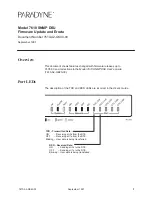
93
Powered Source Equipment (PSE)
Power sourcing equipment (PSE) is a device such as a switch that provides (sources) power on the Ethernet cable. The
maximum allowed continuous output power per cable in IEEE 802.3af is 15.40 W. A later specification, IEEE 802.3at, offers
25.50 W. When the device is a switch, it is commonly called an End-span (although IEEE 802.3af refers to it as endpoint).
Otherwise, if it's an intermediary device between a non PoE capable switch and a PoE device, it's called a Mid-span. An
external PoE injector is a Mid-span device
.
Powered device
A powered device (PD) is a device powered by a PSE and thus consumes energy. Examples include wireless access points, IP
Phones, and IP cameras. Many powered devices have an auxiliary power connector for an optional, external, power supply.
Depending on the PD design, some, none, or all power can be supplied from the auxiliary port, with the auxiliary port sometimes
acting as backup power in case of PoE supplied power failure.
How Power is transferred through the Cable
A standard CAT5 Ethernet cable has four twisted pairs, but only two of these are used for 10BASE-T and 100BASE-TX. The
specification allows two options for using these cables for power, shown in Figure 1 and Figure 2:
The spare pairs are used. Figure 1 shows the pair on pins 4 and 5 connected together and forming the positive supply, and the
pair on pins 7 and 8 connected and forming the negative supply. (In fact, a late change to the spec allows either polarity to be
used).
Figure 6-1:
Power Supplied over the Spare Pins
The data pairs are used. Since Ethernet pairs are transformer coupled at each end, it is possible to apply DC power to the
center tap of the isolation transformer without upsetting the data transfer. In this mode of operation the pair on pins 3 and 6 and
the pair on pins 1 and 2 can be of either polarity.





































